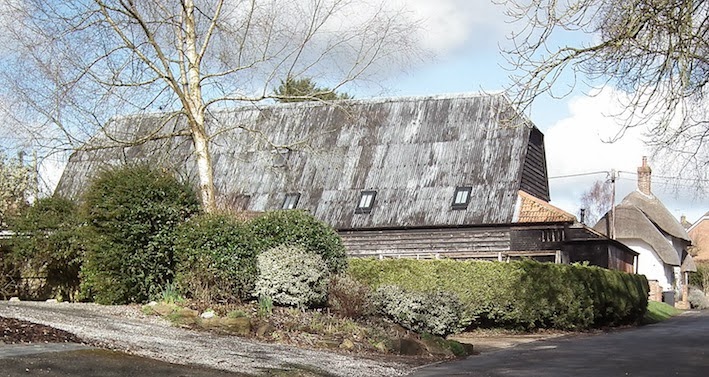Sunday, March 2, 2014
Mildenhall, Wiltshire
On high
Mildenhall (which I'm told is pronounced 'Minal') is roughly east of Marlborough in Wiltshire. The local stone is chalk, and in this area there's a variety of traditional building materials, including brick, flint, and wood, as well as chalk itself. There are quite a few large barns with wooden weatherboarded walls and thatched roofs, but this substantial barn (now clearly converted for some other use) has one of the biggest corrugated iron roofs I've seen recently dwarfing its boarded walls. The corduroy texture of the corrugated iron is if anything emphasized by the material's variegated colour, which seems to be a mixture of black paint and pale areas where the paint has flaked away.
This is such a big roof that the overused word 'awesome' came into my mind as I stared at it. It is clearly made up of three rows of sheets, but I'm not sure how long the sheets are – 8 or 10 feet each, perhaps. Whatever the precise size, it's a lot of corrugated iron to set beside the brick, white-walled, and thatched cottages that stand nearby. But I think it works.
I've been a fan of this kind of use of non-traditional materials in rural settings ever since moving to the Cotswolds. Here the traditional roofing material is honey-coloured Cotswold stone, but many farm buildings have grey slate roofs. I've grown used to listening to pundits bemoaning the fact that farmers dare to roof their buildings with slates, but I'm not convinced that every roof has to look the same or that everything has to be built in stone. I'm even happy to see a bit of rusty wriggly tin now and again on a Cotswold farm.
I feel the same about roofs like this one in Wiltshire. It's practical and effective and it sits rather well above the weatherboarding and behind the white-barked trees and green shrubs that surround it. It has terrific texture too. If corrugated iron is often thought of as a lowly material, a roof like this raises it to fresh heights.
Subscribe to:
Post Comments (Atom)









6 comments:
Very much enjoying your blog! There is a 2009 episode of Time Team in which Phil Harding of Wessex Archaeology and Tony Robinson debate the pronunciation of Mildenhall.
Lili K
Newfoundland, Canada
Thank you, Lili. I've not seen that particular episode of Time Team, bit will look out for it.
Cor, bet it sounds good in there during a hail storm. But beware of 'local' pronunciations. I have been since Candida Lycett Green told of her father John Betjeman telling her and her brother
that 'Godmanchester' was 'Gumster'. I think that's gradually being absorbed as the truth. Marvellous.
"Gumster" - wonderful. I am indeed wary of such things. Have been since being repeatedly told that "Cirencester" is pronounced "Ciceter". Whereas we all know that it's "Ciren".
Whole words have been invented through these viral assertions. The collective noun "flange" for a group of baboons is a famous example, inititated by the TV show Not The Nine O'Clock News and now widely accepted.
Farm buildings could probably justify a blog on their own! I was chatting to some people gathered for a conference on historic farm buildings who were very excited about the subject, and pointed out to me that they can be a lot older than appears at first sight. Despite new top and new sides, how old could this building be? I notice the road comes up to it, as if the barn was there first.
Just to say, rather late in the day, that Mildenhall is indeed pronounced ‘Minal’ by locals.
Post a Comment